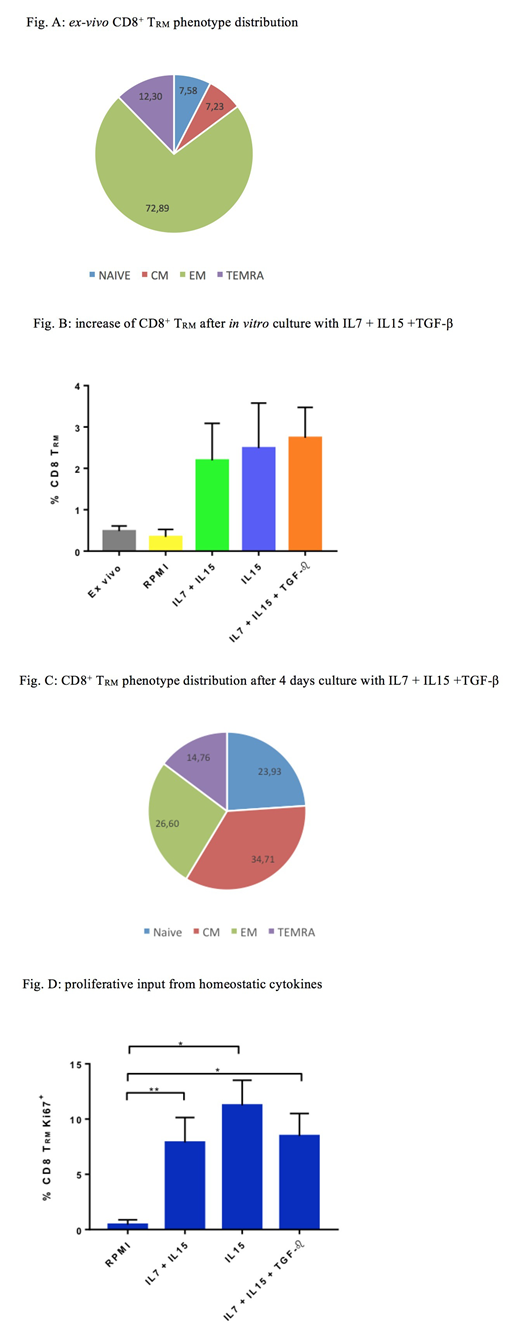Background: CD8+ T cell responses are an essential component of the adaptive immune system. After resolution of infection a small population of memory cells is formed. In relation to circulatory patterns, different subsets of memory CD8+ T cells can be identified: the central memory (CM) and the effector memory T cells (EM) (Martin MD, et al., Front Immunol. 2018). In addition, it has been described a subset of resident memory T cells (TRM) permanently living in peripheral tissues, including the bone marrow (BM) (Di Rosa F., et al., Nat Rev Immunol. 2016). It is conceivable that these cells can contribute to the defence toward haematological tumours infiltrating the BM. Therefore, we performed a study to evaluate the frequency and the phenotype of BM CD8+ TRM in patients with multiple myeloma (MM). Moreover, to evaluate the contribution that the microenvironment can have on the homeostatic and functional maintenance of these cells, we performed in vitro experiments of BM-derived mononucleate cells of MM patients cultured in the presence of different homeostatic cytokines.
Patients and Methods: we prospectively analysed 21 patients, 16 with a new diagnosis of IgA, IgG and light chain multiple myeloma (MM) and 5 with IgA and IgG smoldering myeloma (SM). At the time of the bone marrow assessment, we collected a sample for the flow cytometry analysis and in vitro cell culture. The ex vivo evaluation of CD8+ TRM frequency and phenotype in BM samples was performed using anti-human mAbs to CD3, CD103, CD69, CD45, CD8, CD45RA and CCR7 (CD197). The sequential gating strategy was: gate on lymphocytes population with CD45 vs. SSC, 7AAD negative cells, exclusion of doublets with FSC-H vs. FSC-A, CD8+CD3+ and evaluation of percentage of CD103+CD69+ cells. Was also established the subsets using CCR7 and CD45RA. Moreover, to evaluate the role of the microenvironment on maintenance of these cells, we performed in vitro experiments of BM-derived mononucleate cells of MM patients cultured in the presence of homeostatic cytokines in maintaining these cells for a long time. BM derived mononucleate cells from patients were then cultured in vitro in complete RPMI with 10% of human serum for 4 days with IL15 (25 ng/ml), IL7 (25 ng/ml) and TGF-β (2 ng/ml), in different combination and in RPMI alone. After culture, we analyzed the frequency of CD8+ TRM and the proliferating fraction with intracellular staining with anti human Ki67 APC. Non parametric Mann-Whitney and Kruskall-wallis tests were performed to determine statistical differences in the distribution of the results using GraphPad Prism 7.00. Values of * p<0.05 were considered significant.
Results: the ex vivo average frequency of CD8+ TRM in 16 MM patients was of 0.48% and the phenotype was represented mainly by TEM (72,9%) followed by TEMRA (12.3%) and (7,6%) of naïve cells and (7,2%) of TCM (Fig. A). The comparison with the ex vivo frequency of CD8 TRM in SM patients did not show any significant difference between two groups (data not showed). To evaluate factors capable of maintaining or to induce the expansion of these cells in vitro, we maintained BM-derived mononucleate cells from MM patients for 4 days in presence of homeostatic cytokines, IL-15, IL-7 plus IL-15 and IL-7 together with IL-15 and TGF-β. The result showed an increase of the percentage of CD8+ TRM in all conditions tested, especially in presence of all cytokines (Fig. B), with a percentage of CD8 TRM of 2,74%. Regarding the phenotype distribution, we observed an expansion of CM compared to the other subsets (Fig. C). We also analysed the percentage of CD8+ TRM proliferating through the identification of Ki67 positive cells. Data highlight that IL-15 gives the strongest proliferative input, but also other cytokines contribute to the homeostatic maintenance of these cells (Fig. D).
Conclusions: we evaluated the frequency and the phenotype of CD8 TRM in BM of MM patients compared to SM patients with the conclusion that these cells do not differ significantly in percentage and phenotypic distribution in both conditions. In MM patients, the increase of CD8+ TRM cells with a CM phenotype after in vitro culture with the three cytokines could have an anti-tumor role in the control of MM. Further studies are needed to investigate the cytotoxic capacity of these cells against myeloma cells, in order to study their functional role, also in the perspective of a possible use in future therapeutic programs.
No relevant conflicts of interest to declare.
Author notes
Asterisk with author names denotes non-ASH members.


This feature is available to Subscribers Only
Sign In or Create an Account Close Modal